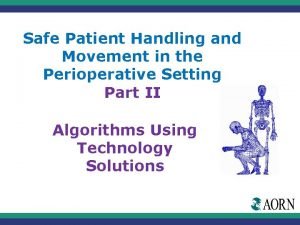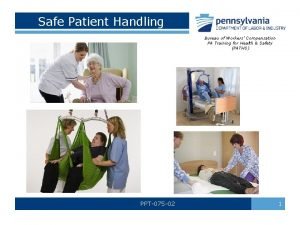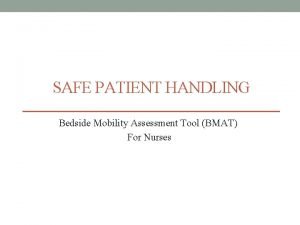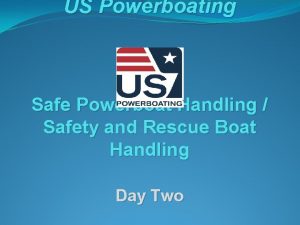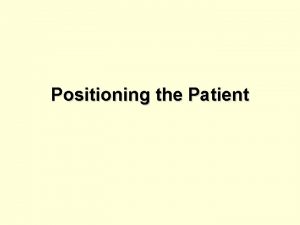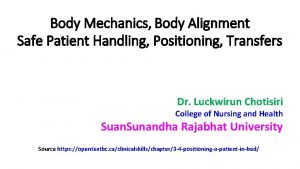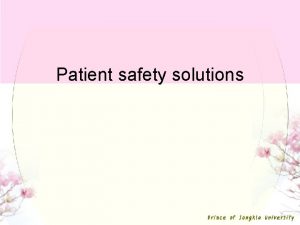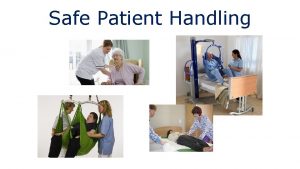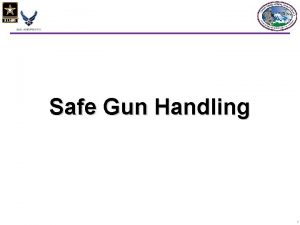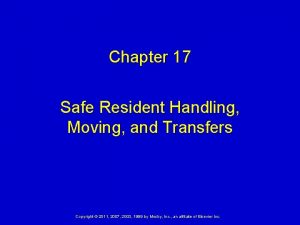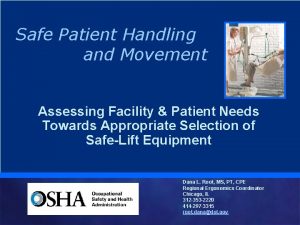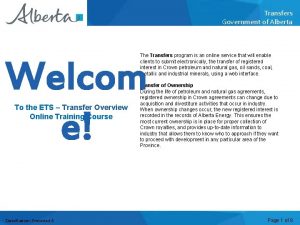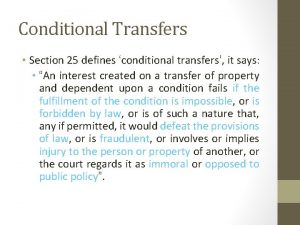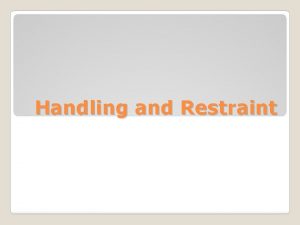Safe Patient Handling and Transfers Safe Patient Handling


















- Slides: 18

Safe Patient Handling and Transfers

Safe Patient Handling: Patient Movement / Transfer Policy “Patient will be safely assisted in all functional mobility, including but not limited to transferring to and from the bed to chair, wheelchair or ambulatory position while using proper lifting and moving techniques or appropriate mechanical lifting devices. ”

Focus on Safety Patient Safety Staff Safety Environmental Safety

Key Points of Safe Transfers - Assure that appropriate footwear is in place / Non skid footwear is REQUIRED. Assess patient prior to transfer to determine assist level needed. Gait belts may be used per patient assessment. Maintain patient dignity. Be alert to increased risk for falls. Proper hand hygiene before and after. Patient should be identified by name and DOB prior to the transfer. Document transfer & patient’s tolerance

Concepts of Body Mechanics Base of Support (BOS): The portion of the body in contact with the floor. Base of Support should be shoulder width apart; it provides support and stability for movement. Center of Gravity (COG): Point where body weight is balanced; it is usually located at the pelvis. Most stable when the Center of Gravity is close to the center of Base of Support.

Rules of Body Mechanics Provide wide base of support. Lift from a comfortable height. Bend your knees and keep your back straight. Avoid Twisting. Keep Load Close to you Body. Avoid Pulling.

Special Considerations If patient starts to fall, ease him/her to closest surface to avoid injury to patient and/or self. If patient has one-sided weakness, follow transfer guidelines but transfer leading with unaffected side (i. e. especially stroke or orthopedic fractures/replacement patients)

Ask the following questions to Determine Transfer Assistance Is the patient able to follow commands? Is the patient able to assist with rolling or supine to sit? Is the patient able to move all four extremities? Is the patient able to scoot on his/her bottom to EOB or chair in sitting? Is the patient able to stand up with a small amount of assist?

Ask the following questions to Determine Transfer Assistance If patient demonstrates little to no ability to stand, he/she should be transferred using mechanical lift. What mechanical lift is available? Where is mechanical lift stored on your unit? Consider placing bed in “chair” position as last resort if unable to transfer OOB (out of bed)

Positioning in Bed Raise the bed to at least waist level to limit bending forward. Have the patient grab bed rail to assist with turning from side to side. When scooting to HOB, lower the head of bed and instruct the patient to assist by pushing with legs and using arms on bedrails. Use two staff members.

Assisting from Supine to Sitting at EOB Instruct the patient to roll onto his/her side and to bring his/her legs off of the bed. Support the patient at the shoulders and have the patient push up from the bed. Consult with PT or OT if the patient is on hip or back precautions.

Supine to Edge of Bed (EOB)

Bed to Chair Transfer • Prior to transfer, position the chair close to the bed. MAKE SURE ALL LOCKS ARE ACTIVATED. • Assist the patient to a sitting position and allow the patient sit upright for a few moments. ASSESS FOR DIZZINESS. • Instruct the patient to scoot forward on the EOB with feet on the floor. • Have the patient to lean forward – having him/her use arms to push up from bed. • Assist the patient into standing (by using gait belt or by supporting patient at buttocks/trunk) and instruct the patient to place hands on the device. • Assist patient to pivot buttocks or ask patient to take steps to turn toward chair. • Assist to slowly lower to transfer surface.

Bed to Chair Transfer

Two Person Assist Transfers • Use the basic techniques described in preceding guidelines. • Prior to transfer, discuss plan with other team member & patient. • Both staff members need to position selves as close to patient as possible. • One team member needs to be “lead” individual for transfer.

Sliding Board Transfer • Can be useful if patient has good use of arms but limited use of legs • Make the bed surface as even to chair surface as possible (try to avoid “going uphill”) • Transfer boards should not be used with chairs with arms (w/c with removable armrests preferred) • Position board under ½ of patient’s buttocks • Take extra care if patients have wounds on buttocks or at risk for shearing injury

Sliding Board Transfers

Adjusting Assistive Device • For best use and safety, assistive devices (walkers, crutches & canes) should be adjusted to patient’s height • When patient standing upright, the bend of their wrist should be at height of hand grip of device
 Safe patient transfers
Safe patient transfers Handling patients
Handling patients Safe patient handling
Safe patient handling Bedside tool
Bedside tool Safe handling of pesticides
Safe handling of pesticides Gun etiquette rules
Gun etiquette rules Us powerboating
Us powerboating Savage safe handling auburn maine
Savage safe handling auburn maine Safe feed safe food
Safe feed safe food Safe people safe places
Safe people safe places Horizontal
Horizontal Safe patient positioning
Safe patient positioning Patient safety solutions
Patient safety solutions Patient 2 patient
Patient 2 patient Chapter 32 admissions transfers and discharges
Chapter 32 admissions transfers and discharges Chapter 10 positioning transfers and ambulation
Chapter 10 positioning transfers and ambulation A wave is a repeating disturbance that transfers energy
A wave is a repeating disturbance that transfers energy Waves are repeating disturbances that transfer
Waves are repeating disturbances that transfer Frequency and wavelength relation
Frequency and wavelength relation

